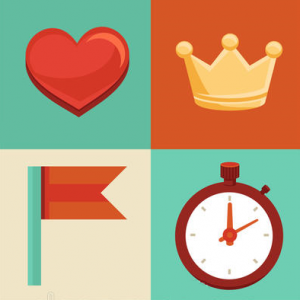 There are numerous game components that can be used in gamification.
There are numerous game components that can be used in gamification.
Points: It is a convenient tool for rewarding the player performance in a game. Points provide players a summary of their success. Points allow users to record their past performances, try to perform better, follow their long-term playing performance (while fulfilling a game objective that lasts for hours or days) and compare their performance with other players. Additionally, in gamification, monetary rewards related to user performance are mostly given through points that can be converted into money. The points can be more valuable if they are going to be spent in special partner places (such as flight tickets, fuel discounts, cinema tickets, selected restaurants and etc.). There can also be different points to reward different performances in a game. The main challenges in gamification design related to points is to distribute them in a fair way and to adjust their convertibility to real money.
Achievement/Badges: Achievements are used to assign a number of optional secondary tasks to the players. They are deployed to have multi-tasking players, improving player effectiveness and providing additional challenges. Achievements are mostly accepted by experienced players and explorer type players, who are not satisfied by the primary tasks and look for more challenges and content in the game. Badges are the permanent titles given to players when achievements are unlocked. The players usually have an inventory of badges, to summarize their performances in secondary tasks and showing their reputation in social game interactions. Badges usually have different titles and sometimes groups, enabling game managers to evaluate different performances of players in long-term play.
Leaderboards: Leaderboards support competition, as an embedded comparison interface, that occurs after a defined time period, summarizing player performances and allowing players to compare their performance with each other. Leaderboards provide additional motivational functions, such as comparing the different performances of the same players and clustering gamers under some groups (like countries) to promote players to collaborate and act as a society. It is particularly useful in cases where players are not forming teams, but the game managers want them to act together to perform better.
Besides the most typical PBL approach (Points, badges and leaderboards), there are much more elements:
Levels: The level in a game has two distinct meanings. The first one defines the parts of a proceeding game (usually proportional with task difficulty) and the second represents the player experience. The latter meaning is popularly adopted in gamification design showing the loyalty of a participator. It is useful for distinguishing newcomers and experienced players. Levels allow the game to distribute the tasks with different challenges to skilled and amateur players; while improving player reputation in social game interactions. From the perspective of the gamified process managers, high-level players are more reliable compared to low-level players, because of gaming skills, loyalty and past experiences.
Avatars: Visual representation of player’s character.
Boss Fights: A difficult challenge to provide tension in specific (and less frequent) parts of a game.
Combat: Battles promote competition for short periods of time.
Content Unlocking: Special game content for players that fulfill some tasks.
Gifting: Allowing players to share their resources with each other.
Social Graphs: The representation of the user’s social network in the game.
Teams: A group of players that work together to reach a common goal.
Collections: Sets of items or badges to accumulate.
Virtual G oods: Game assets with perceived or real-money value.
Source: Our ongoing project GReSBAS

Comments are closed.